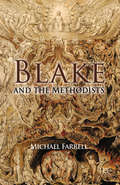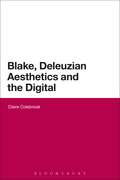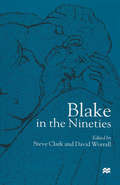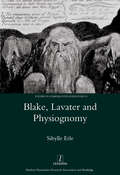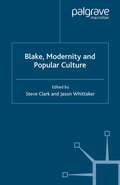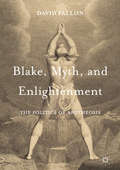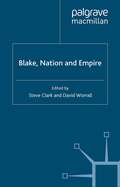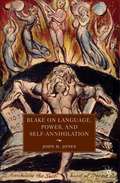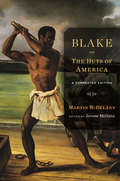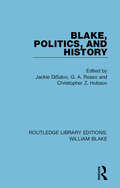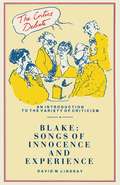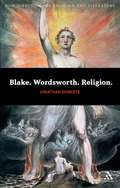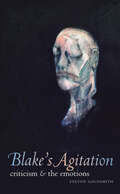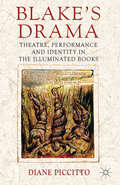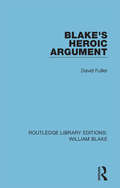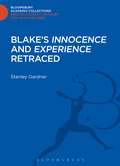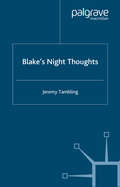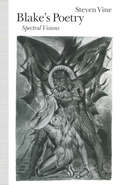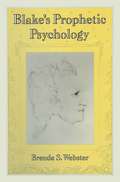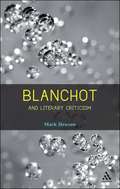- Table View
- List View
Blake and the Methodists
by M. FarrellExploring the work of William Blake within the context of Methodism – the largest 'dissenting' religious group during his lifetime – this book contributes to ongoing critical debates surrounding Blake's religious affinities by suggesting that, contrary to previous thinking, Blake held sympathies with certain aspects of Methodism.
Blake, Deleuzian Aesthetics, and the Digital (Continuum Literary Studies)
by Claire ColebrookDrawing on recent theories of digital media and on the materiality of words and images, this fascinating study makes three original claims about the work of William Blake. First, Blake offers a critique of digital media. His poetry and method of illuminated printing is directed towards uncovering an analogical language. Second, Blake's work can be read as a performative. Finally, Blake's work is at one and the same time immanent and transcendent, aiming to return all forms of divinity and the sacred to the human imagination, stressing that 'all deities reside in the human breast,' but it also stresses that the human has powers or potentials that transcend experience and judgement: deities reside in the human breast. These three claims are explored through the concept of incarnation: the incarnation of ideas in words and images, the incarnation of words in material books and their copies, the incarnation of human actions and events in bodies, and the incarnation of spirit in matter.
Blake, Deleuzian Aesthetics, and the Digital (Continuum Literary Studies)
by Claire ColebrookDrawing on recent theories of digital media and on the materiality of words and images, this fascinating study makes three original claims about the work of William Blake. First, Blake offers a critique of digital media. His poetry and method of illuminated printing is directed towards uncovering an analogical language. Second, Blake's work can be read as a performative. Finally, Blake's work is at one and the same time immanent and transcendent, aiming to return all forms of divinity and the sacred to the human imagination, stressing that 'all deities reside in the human breast,' but it also stresses that the human has powers or potentials that transcend experience and judgement: deities reside in the human breast. These three claims are explored through the concept of incarnation: the incarnation of ideas in words and images, the incarnation of words in material books and their copies, the incarnation of human actions and events in bodies, and the incarnation of spirit in matter.
Blake in the Nineties
by Steve Clark David WorrallThe 1990s have witnessed a major reassessment of Blake initiated by a new and more rigorous comprehension of his modes of production, which in turn has led to re-evaluation of other literary and cultural contexts for his work. Blake in the Nineties grapples with the implications of the new bibliography for Blake studies, in its editorial, interpretative, and historical dimensions. As well as providing an international overview of recent Blake criticism, the collection contributes to current debates in a variety of disciplines dealing with the Romantic period, including art history, counter-Enlightenment-scholarship, theology and hermeneutic theory.
Blake, Lavater, and Physiognomy
by Sibylle Erle"William Blake never travelled to the continent, yet his creation myth is far more European than has ever been acknowledged. The painter Henry Fuseli introduced Blake to traditional European thinking, and Blake responded to late 18th century body-theory in his Urizen books (1794-95), which emerged from his professional work as a copy-engraver on Henry Hunter's translation of Johann Caspar Lavater's Essays on Physiognomy (1789-98). Lavater's work contains hundreds of portraits and their physiognomical readings. Blake, Fuseli, Joshua Reynolds and their contemporaries took a keen interest in the ideas behind physiognomy in their search for the right balance between good likeness and type in portraits. Blake, Lavater, and Physiognomy demonstrates how the problems occurring during the production of the Hunter translation resonate in Blake's treatment of the Genesis story. Blake takes us back to the creation of the human body, and interrogates the idea that 'God created man after his own likeness.' He introduces the 'Net of Religion', a device which presses the human form into material shape, giving it personality and identity. As Erle shows, Blake's startlingly original take on the creation myth is informed by Lavater's pursuit of physiognomy: the search for divine likeness, traced in the faces of their contemporary men."
Blake, Lavater, and Physiognomy
by Sibylle Erle"William Blake never travelled to the continent, yet his creation myth is far more European than has ever been acknowledged. The painter Henry Fuseli introduced Blake to traditional European thinking, and Blake responded to late 18th century body-theory in his Urizen books (1794-95), which emerged from his professional work as a copy-engraver on Henry Hunter's translation of Johann Caspar Lavater's Essays on Physiognomy (1789-98). Lavater's work contains hundreds of portraits and their physiognomical readings. Blake, Fuseli, Joshua Reynolds and their contemporaries took a keen interest in the ideas behind physiognomy in their search for the right balance between good likeness and type in portraits. Blake, Lavater, and Physiognomy demonstrates how the problems occurring during the production of the Hunter translation resonate in Blake's treatment of the Genesis story. Blake takes us back to the creation of the human body, and interrogates the idea that 'God created man after his own likeness.' He introduces the 'Net of Religion', a device which presses the human form into material shape, giving it personality and identity. As Erle shows, Blake's startlingly original take on the creation myth is informed by Lavater's pursuit of physiognomy: the search for divine likeness, traced in the faces of their contemporary men."
Blake, Modernity and Popular Culture
by S. Clark J. WhittakerThis book explores the ways in which Blake reacted to the subcultures of his day, as well as how he has inspired popular, modernist and postmodernist figures until the present day. Blake's influence on later generations of writers and artists is more important than ever, extending into film, psychology, children's literature and graphic novels.
Blake, Myth, and Enlightenment: The Politics of Apotheosis
by David FallonThis book provides compelling new readings of William Blake’s poetry and art, including the first sustained account of his visionary paintings of Pitt and Nelson. It focuses on the recurrent motif of apotheosis, both as a figure of political authority to be demystified but also as an image of utopian possibility. It reevaluates Blake’s relationship to Enlightenment thought, myth, religion, and politics, from The French Revolution to Jerusalem and The Laocoön. The book combines careful attention to cultural and historical contexts with close readings of the texts and designs, providing an innovative account of Blake’s creative transformations of Enlightenment, classical, and Christian thought.
Blake, Nation and Empire
by D. Worrall S. ClarkThis book examines Blake's work in the context of discourses of nation and empire, of the construction of a public sphere, and restores the longevity to his artistic career by placing emphasis on his work in the 1820s. Relevant contexts include technology, sentimentalism, Ireland and Catholic Emancipation, missionary prospectuses and body politics.
Blake on Language, Power, and Self-Annihilation
by J. JonesAgainst a historical backdrop that includes eighteenth-century language theory, children's literature and education, debates on the French Revolution, Biblical interpretation, and print culture, Blake on Language, Power, and Self-Annihilation breaks new ground in the study of William Blake. This book analyzes the concept of self-annihilation in Blake s work, using the language theories of Mikhail Bakhtin to elucidate the ways in which his discourse was open to the viewpoints of others, undermines institutional authority, and restores dialogue. This book not only uncovers the importance of self-annihilation to Blake's thinking about language and communication, but it also develops its centrality to Blake's poetic practice.
Blake; Or, The Huts of America: Or, The Huts Of America
by Martin R. DelanyMartin R. Delany’s Blake (c. 1860) tells the story of Henry Blake’s escape from a southern plantation and his travels in the U.S., Canada, Africa, and Cuba on a mission to unite blacks of the Atlantic region in the struggle for freedom. Jerome McGann’s edition offers the first correct printing of the work and an authoritative introduction.
Blake, Politics, and History (Routledge Library Editions: William Blake)
by Jackie DiSalvo G. A. Rosso Christopher Z. HobsonFirst published in 1998, this book formed part of an ongoing effort to restore politics and history to the centre of Blake studies. It adopts a three pronged approach when presenting its essays, seeking to promote a return to the political Blake; to deepen the understanding of some of the conversations articulated in Blake’s art by introducing new, historical material or new interpretations of texts; and to highlight differing perspectives on Blake’s politics among historically focused critics. The collection contains essays with varying methodological assumptions and differing positions on questions central to historicist Blake scholarship.
Blake, Politics, and History (Routledge Library Editions: William Blake #Vol. 17)
by G. A. Rosso Christopher Z. Hobson Jackie DisalvoFirst published in 1998, this book formed part of an ongoing effort to restore politics and history to the centre of Blake studies. It adopts a three pronged approach when presenting its essays, seeking to promote a return to the political Blake; to deepen the understanding of some of the conversations articulated in Blake’s art by introducing new, historical material or new interpretations of texts; and to highlight differing perspectives on Blake’s politics among historically focused critics. The collection contains essays with varying methodological assumptions and differing positions on questions central to historicist Blake scholarship.
Blake. Wordsworth. Religion. (New Directions in Religion and Literature)
by Jonathan RobertsA reassessment of Romantic religion and the structure of modern religious debate argued through the history of interpretation of Blake's and Wordsworth's religious visions.
Blake's Agitation: Criticism and the Emotions
by Steven GoldsmithBlake’s Agitation is a thorough and engaging reflection on the dynamic, forward-moving, and active nature of critical thought. Steven Goldsmith investigates the modern notion that there’s a fiery feeling in critical thought, a form of emotion that gives authentic criticism the potential to go beyond interpreting the world. By arousing this critical excitement in readers and practitioners, theoretical writing has the power to alter the course of history, even when the only evidence of its impact is the emotion it arouses. Goldsmith identifies William Blake as a paradigmatic example of a socially critical writer who is moved by enthusiasm and whose work, in turn, inspires enthusiasm in his readers. He traces the particular feeling of engaged, dynamic urgency that characterizes criticism as a mode of action in Blake’s own work, in Blake scholarship, and in recent theoretical writings that identify the heightened affect of critical thought with the potential for genuine historical change. Within each of these horizons, the critical thinker’s enthusiasm serves to substantiate his or her agency in the world, supplying immediate, embodied evidence that criticism is not one thought-form among many but an action of consequence, accessing or even enabling the conditions of new possibility necessary for historical transformation to occur. The resulting picture of the emotional agency of criticism opens up a new angle on Blake’s literary and visual legacy and offers a vivid interrogation of the practical potential of theoretical discourse.
Blake's Agitation: Criticism and the Emotions
by Steven GoldsmithBlake’s Agitation is a thorough and engaging reflection on the dynamic, forward-moving, and active nature of critical thought. Steven Goldsmith investigates the modern notion that there’s a fiery feeling in critical thought, a form of emotion that gives authentic criticism the potential to go beyond interpreting the world. By arousing this critical excitement in readers and practitioners, theoretical writing has the power to alter the course of history, even when the only evidence of its impact is the emotion it arouses. Goldsmith identifies William Blake as a paradigmatic example of a socially critical writer who is moved by enthusiasm and whose work, in turn, inspires enthusiasm in his readers. He traces the particular feeling of engaged, dynamic urgency that characterizes criticism as a mode of action in Blake’s own work, in Blake scholarship, and in recent theoretical writings that identify the heightened affect of critical thought with the potential for genuine historical change. Within each of these horizons, the critical thinker’s enthusiasm serves to substantiate his or her agency in the world, supplying immediate, embodied evidence that criticism is not one thought-form among many but an action of consequence, accessing or even enabling the conditions of new possibility necessary for historical transformation to occur. The resulting picture of the emotional agency of criticism opens up a new angle on Blake’s literary and visual legacy and offers a vivid interrogation of the practical potential of theoretical discourse.
Blake's Drama: Theatre, Performance and Identity in the Illuminated Books
by Diane PiccittoBlake's Drama challenges conventional views of William Blake's multimedia work by reinterpreting it as theatrical performance. Viewed in its dramatic contexts, this art form is shown to provoke an active spectatorship and to depict identity as paradoxically essential and constructed, revealing Blake's investments in drama, action, and the body.
Blake's Heroic Argument (Routledge Library Editions: William Blake)
by David FullerFirst published in 1988, this book is a study of all Blake’s work in illuminated printing. It traces in particular, the development of his ideas on politics, religion, sexuality, and the imagination. There are substantial sections on some of Blake’s best-known works, including the Marriage of Heaven and Hell, and the Songs of Innocence and Experience, and full critical essays on the Four Zoas and Jerusalem. The book describes the historical contexts of Blake’s work, and sets it in relation to the political controversies of his age as these are reflected in the writings of Burke, Paine and Mary Wollstonecraft. It discusses the relationships of text and design in Blake, the characteristic verbal textures and rhythms of his longer poems, some influences on his thought, and developing structure of his personal myth and its relationship to other mythologies. The opening chapter discusses areas of fundamental disagreement with some of the main approaches to Blake whilst the final chapter discusses literary theory and the practice of criticism, arguing for an open and explicit involvement of personal experience and values and a more creative use of form in critical writing.
Blake's Heroic Argument (Routledge Library Editions: William Blake #2)
by David FullerFirst published in 1988, this book is a study of all Blake’s work in illuminated printing. It traces in particular, the development of his ideas on politics, religion, sexuality, and the imagination. There are substantial sections on some of Blake’s best-known works, including the Marriage of Heaven and Hell, and the Songs of Innocence and Experience, and full critical essays on the Four Zoas and Jerusalem. The book describes the historical contexts of Blake’s work, and sets it in relation to the political controversies of his age as these are reflected in the writings of Burke, Paine and Mary Wollstonecraft. It discusses the relationships of text and design in Blake, the characteristic verbal textures and rhythms of his longer poems, some influences on his thought, and developing structure of his personal myth and its relationship to other mythologies. The opening chapter discusses areas of fundamental disagreement with some of the main approaches to Blake whilst the final chapter discusses literary theory and the practice of criticism, arguing for an open and explicit involvement of personal experience and values and a more creative use of form in critical writing.
Blake's 'Innocence' and 'Experience' Retraced (Bloomsbury Academic Collections: English Literary Criticism)
by Stanley GardnerThis major work of historical and interpretative scholarship draws upon fresh evidence to set the Songs in a new perspective. Blake's etchings are substantially discussed alongside the poems they illustrate. The plates of both Innocence and Experience are considered in detail as Blake's response to social circumstances between 1782 and 1794. The reader is asked to re-think the nature of 'the Two Contrary States', and the relationship of the designs to the understanding of Blake.
Blake's Night Thoughts
by J. TamblingBlake's Night Thoughts discusses Blake as a poet and artist of night, considering night through graveyard poetry and Young in the eighteenth-century, urbanism in the nineteenth and Levinas and Blanchot's writings in the twentieth. Taking 'night' as the breakdown of rational progressive thought and of thought based on concepts of identity, the book reads the lyric poetry, some Prophetic works, including a chapter on The Four Zoas , the illustrations to Young, and Dante, and look's at Blake's writing of madness.
Blake’s Poetry: Spectral Visions
by Steven Vine Stephen R. MandellWilliam Blake is acknowledged as a poet of opposition and contradiction: a writer who, from Songs of Innocence and Experience to his last epic Jerusalem, ceaselessly explored the conflicts between limitation and possibility, reason and energy, torment and joy. But the contradictions within Blake's own 'visionary' poetics are less often considered. Throughout his work, Blake powerfully dramatises the energies and agonies of his own poetic labour.
Blanchot and Literary Criticism
by Mark HewsonBlanchot's writings on literature have imposed themselves in the canon of modern literary theory and yet have remained a mysterious presence. This is in part due to their almost hypnotic literary style, in part due to their distinctive amalgam of a number of philosophical sources (Hegel, Heidegger, Levinas, Bataille), which, although hardly unknown in the Anglophone philosophical world, have not yet made themselves fully at home in literary theory. This book aims to make visible the coherence of Blanchot's critical project. To recognize the challenge that Blanchot represents for literary criticism, one has to see that he always has in view the self-interrogation that characterizes modern literature, both in its theory and its practice. Blanchot's essays study the forms and the paths of this research, its solutions and its impasses; and increasingly, they sketch out the philosophical and historical horizon within which its significance appears. The effect is to revise the terms in which we see the genesis of the modern literary concept, not least of the manifestations of which is literary criticism itself.
